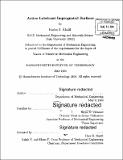| dc.contributor.advisor | Kripa K. Varanasi. | en_US |
| dc.contributor.author | Khalil, Karim S. (Karim Samir) | en_US |
| dc.contributor.other | Massachusetts Institute of Technology. Department of Mechanical Engineering. | en_US |
| dc.date.accessioned | 2014-12-08T18:51:24Z | |
| dc.date.available | 2014-12-08T18:51:24Z | |
| dc.date.copyright | 2014 | en_US |
| dc.date.issued | 2014 | en_US |
| dc.identifier.uri | http://hdl.handle.net/1721.1/92136 | |
| dc.description | Thesis: S.M., Massachusetts Institute of Technology, Department of Mechanical Engineering, 2014. | en_US |
| dc.description | Cataloged from PDF version of thesis. | en_US |
| dc.description | Includes bibliographical references (pages 47-50). | en_US |
| dc.description.abstract | This thesis presents the design and testing of actively controlled lubricant-impregnated surfaces for enhanced droplet mobility and manipulation. Droplet manipulation and mobility on non-wetting surfaces is of practical importance for diverse applications ranging from micro-fluidic devices, anti-icing, drop-wise condensation and biomedical devices, however most of the time droplets are moved passively. The use of active external fields has been explored via electric, acoustic and vibrational fields, yet moving highly conductive and viscous fluids remains a challenge. Magnetic fields have been used for droplet manipulation, however the fluid is usually functionalized to be magnetic, and requires enormous fields of superconducting magnets when transitioning to diamagnetic materials such as water. This thesis presents a new class of active surfaces by impregnating active fluids such as ferrofluids into a textured surface. Droplets on such ferrofluid-impregnated surfaces have extremely low hysteresis and high mobility such that they can be propelled by applying relatively low magnetic fields. Our surface is able to manipulate a variety of materials including diamagnetic, conductive and highly viscous fluids, and additionally solid particles. The surface's droplet propulsion mechanism is described, and is demonstrated to operate independently of the fluid or solid's physical properties that normally inhibit motion (such as conductivity, viscosity, magnetization). In addition, several previous methods for droplet manipulation require pre-fabricated channels that govern the path of the fluid, however we are able to achieve precise control of droplets on a free surface along complex paths, which allows for the use of a single surface for any number of lab-on-a-chip applications and designs. | en_US |
| dc.description.statementofresponsibility | by Karim S. Khalil. | en_US |
| dc.format.extent | 50 pages | en_US |
| dc.language.iso | eng | en_US |
| dc.publisher | Massachusetts Institute of Technology | en_US |
| dc.rights | M.I.T. theses are protected by copyright. They may be viewed from this source for any purpose, but reproduction or distribution in any format is prohibited without written permission. See provided URL for inquiries about permission. | en_US |
| dc.rights.uri | http://dspace.mit.edu/handle/1721.1/7582 | en_US |
| dc.subject | Mechanical Engineering. | en_US |
| dc.title | Active lubricant-impregnated surfaces | en_US |
| dc.type | Thesis | en_US |
| dc.description.degree | S.M. | en_US |
| dc.contributor.department | Massachusetts Institute of Technology. Department of Mechanical Engineering | |
| dc.identifier.oclc | 896164218 | en_US |
